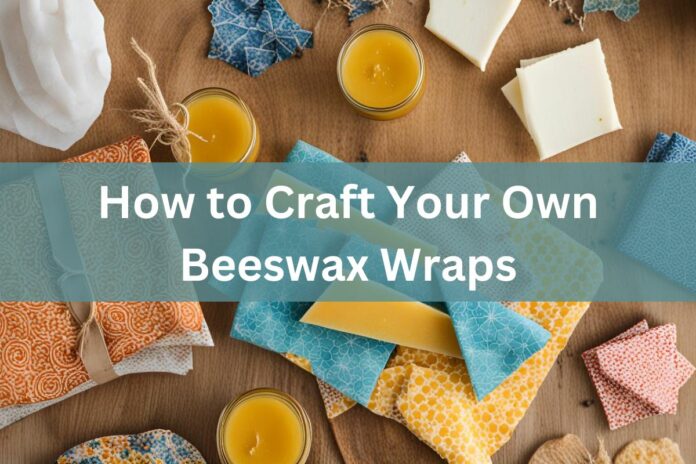DIY: How to Craft Your Own Beeswax Wraps – Just like any other DIY process, making beeswax wraps is quite soothing and brings about your hidden creativity. In this article, we will be taking a look at how to craft your own beeswax wraps.
Table of Contents
Can I make beeswax wraps at home?
You can actually craft beeswax wraps at home and crafting your own beeswax wraps at home is not only fun but also an eco-friendly process.
The fact is that you’ll find a plethora of ways to do this, and one popular method involves utilizing your oven at a low temperature.
You can begin this by laying out your chosen fabric on a baking sheet lined with parchment paper to prevent any wax spillage. You can then proceed to scatter beeswax pellets or grate beeswax directly onto the fabric. It works in a way that as the oven warms, the wax melts and seeps into the fabric fibers.
This actually creates a protective coating. For an even application, a brush can be used to spread the melted wax evenly across the cloth.
What is the best fabric to make beeswax wraps?
While considering making beeswax wraps, you must know the best fabric to use. While researching for this article, we found out that in order to create beeswax wraps, you are required to opt for 100% cotton fabric and this is because of its absorbency.
Additionally, lighter, non-stretch fabrics work best, as these fabrics require less wax and offer greater flexibility.
You have to begin by washing and cutting the fabric into desired shapes with pinking shears and this is to prevent fraying. In order to get what suits your needs, try experimenting with sizes and patterns.
These wraps are versatile for storing food and reducing plastic waste. With proper care, they can last up to a year. One thing that crafting your own wraps does for you is that they allow for customization and promote sustainability by providing an eco-friendly alternative to single-use plastics.
What are the ingredients in beeswax wraps?
In order to successfully make beeswax wraps, you must first know the ingredients that you will need as discovering the ingredients for beeswax wraps unveils a natural concoction for eco-friendly food preservation.
The ingredients that are commonly used for beeswax wraps are beeswax, jojoba oil, and tree resin. Begin by combining the jojoba oil with the pine resin and the beeswax pellets in a mason jar or measuring cup.
Go ahead and melt the mixture using a double boiler, stirring until it reaches a smooth consistency. This simple yet effective mixture provides a sustainable alternative.
Can you make beeswax wraps without pine resin?
Wondering if beeswax wraps can be crafted sans pine resin? Well, you can craft beeswax wraps without pine resin, and this is due to the fact that pine resin isn’t a mandatory ingredient.
However, it does offer a unique adhesive quality which is similar to traditional clingfilm, and enhances the wraps’ ability to adhere.
If you decide not to use pine resin, don’t brood about it too much as the absence of resin won’t hinder the functionality of your homemade wraps as they can effectively be used for the intended purpose as the beeswax and jojoba oil mixture alone provides a protective layer.
Why are my homemade beeswax wraps not sticky?
When you encounter the problem of your homemade beeswax wraps not being sticky, I would suggest that you should not panic. This is a common occurrence, especially when the wraps are new or cold.
There is a way that you can activate the stickiness and this can be done by scrunching the wrap between your hands. This action warms up the beeswax and encourages it to adhere more effectively.
Can I use avocado oil for beeswax wraps?
Crafting your own beeswax wraps is a straightforward process with versatile ingredient options. Using avocado oil is entirely up to you.
It is a known fact that avocado oil is a fantastic option among many others like almond, sunflower, apricot, soy, rice bran, or canola oil.
With this in mind, exploring different combinations of beeswax and vegetable oils allows you to tailor the wraps to your preferences and needs.
Whether you’re drawn to the luxurious richness of avocado oil or prefer the lightness of sunflower oil, there’s ample room for experimentation and creativity in crafting your ideal beeswax wraps.
How to Craft Your Own Beeswax Wraps
Crafting your own beeswax wraps provides a sustainable and customizable alternative to single-use plastic wraps.
You can begin by gathering 100% cotton fabric, beeswax pellets, pine resin (optional), and vegetable oil.
Proceed to wash and cut the fabric into desired shapes, then melt the ingredients in a double boiler. Coat the fabric evenly with the melted mixture using a brush. You have to ensure a thorough coverage.
At this point, you have to allow the wraps to cool and harden before testing their stickiness by wrapping them around containers or food items.
Source: www.Muzhchin.net
